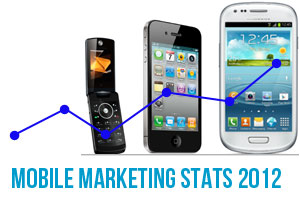SMS Marketing Statistics 2012
In today’s world, anywhere from 95-98% of text messages received are opened and read within minutes of receipt. Because of this, SMS marketing is growing quickly as a means of delivering marketing messages to clients and customers. This kind of marketing can be a great benefit to any kind of company. However you use text message marketing to reach your audience, you’re sure to get attention. Still not so sure? Take a peek at these SMS Marketing Statistics 2012 and see just how powerful SMS marketing can be.
For starters: With Four billion mobile phones out there, 86% of mobile users said that they receive or send at least one text message per week, though often it is much more. Last year alone, 7.8 trillion SMS messages were sent. It is estimated that SMS traffic will reach, if not surpass, 9.6 trillion messages by the end of this year,
25% of all of those four billion registered phones are smart phones and of those consumers using mobile phones, 30% of households said that they no longer even had a landline in their homes. Over one third of mobile phone users said that they actually prefer text messaging as a means of communication over a phone call on that same mobile device. 44% of people said that they are apt to check their phones an average of at least 10 times a day.
95% of all mobile users (both smartphone and non-smartphone users) have been connected to by brands that are using SMS marketing to reach their customers. Regarding ad awareness, the average mobile based campaign utilizing SMS marketing significantly outpaces online ads. One third of consumers say they interact with a brand via text message on a regular basis. They do this by opting in to regular messages with promotions and incentives on the brand’s website, scanning QR codes, or texting in keywords to a mobile short code.
Of the 250 million mobile users in the United States, about one fourth use their phones to access the internet for browsing, searches, shopping, games, and more. 9/10 mobile searches lead to action, and half of these searches eventually lead to a purchase. With 50% of local searches being performed on mobile devices, it’s pretty clear that mobile isn’t going anywhere. Why not use it to your advertising advantage?
Speaking of advantages, here are some that SMS marketing offers:
In all the emails received each day, so many are spam: upwards of 30%! Users have found their way around this with spam filters, and are less likely to open an email they find unfamiliar because of this. In SMS marketing, though, only about 10% of daily received messages are considered spam. Because of this, users aren’t as prone to brush them off without first reading through them. This reading through often leads to further action. For some facts: Only about 6% of marketing emails are opened and responded to, while SMS Marketing campaigns have a much higher response rate-45% to be specific.

With all the marketing images consumers see daily, marketers constantly have to create new, engaging imagery and campaigns all the time. The fact that SMS messages are direct to the customer is definitely a big plus- even if someone is on the go, they’re very likely to check their text messages and see what you have to say. Another perk is that there is so much less need to compete with other media in this form, because it is a fairly new way of marketing products and ideas to clients.
With all of these statistics in your favor, it’s not hard to see why SMS marketing is a great tool to add to your marketing repertoire!






